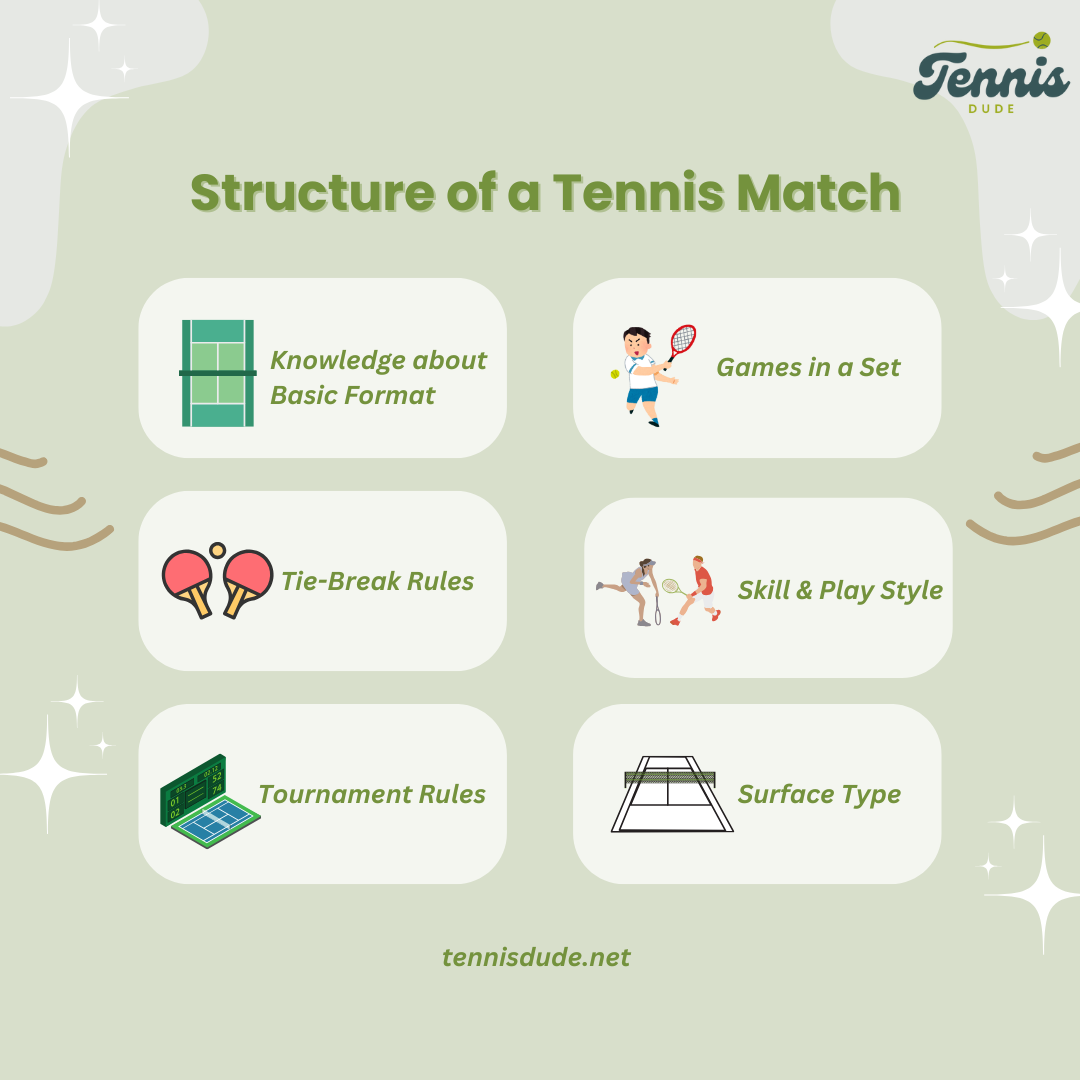Table of Contents
Tennis is a game that hooks fans and players alike with its thrilling mix of precision, strategy, and energy. From nailing down the rules and getting a feel for key terms to figuring out the doubles game and timing of matches, every bit of tennis knowledge brings you closer to acing the court. This guide is here to serve (pun intended!) everything you need to know about the length of a tennis match, covering the essentials, structure, and rules to get you game-ready. So grab your racket, and let’s jump right in.
Structure of a Tennis Match
Below is the general structure of a tennis match:
Basic Format
To win a match, players compete for sets and games, typically in a best-of-three or best-of-five sets format. Get the sets, win the match!
- Sets & Games: Each set has a series of games.
- Winning: Players need a certain number of sets to clinch the match.
Games in a Set
Each set requires six game wins, with a two-game lead to secure it. If both hit six games, it’s tie-break time!
- 6 Games to Win: Get six games with a two-game lead.
- Tie-Break Alert: If it’s 6-6, prepare for a tiebreak!
Tie-Break Rules
Tie-breaks crank up the tension! First to seven points wins, but you need a two-point lead to take it.
- 7 Points to Win: Score seven points with a two-point lead.
- Deuce Drama: If tied at six, play until someone’s two points ahead.
Skill & Play Style
Player tactics and styles have a big impact. Power players aiming for quick points with strong serves often shorten matches. In contrast, players who rely on long rallies can really stretch the game out.
- Power Play = Faster: Big serves, fast points.
- Long Rallies = Slower: More strategy, more time.
Tournament Rules
Tournament rules also play a role. Grand Slam men’s singles matches are best-of-five sets, meaning they last longer, while women’s singles are best-of-three, usually making them shorter.
- Grand Slam (Men’s): Best of 5, longer.
- Women’s Singles: Best of 3, typically shorter.
Surface Type
The court’s surface can affect the speed. Grass courts (like Wimbledon) favor quicker points, while clay courts (like the French Open) slow the ball down, leading to extended rallies.
- Grass Courts: Fast play, shorter matches.
- Clay Courts: Slow rallies, longer games.
Legendary Marathon Matches
Some matches are truly epic! The 2010 Wimbledon match between John Isner and Nicolas Mahut lasted 11 hours and 5 minutes over three days, ending 70-68 in the final set. Another long one? The 2018 Wimbledon semifinal between Kevin Anderson and John Isner lasted 6 hours and 36 minutes!
- 2010 Wimbledon: Isner vs. Mahut – 11 hours, 5 minutes.
- 2018 Wimbledon Semifinals: Anderson vs. Isner – 6 hours, 36 minutes.
How Long Does a Tennis Match Last?
The duration of singles and doubles matches varies depending on the match type.
Singles Matches
In general, singles matches at the professional level last between 1.5 to 4 hours. However, matches can exceed this range, especially in the case of best-of-five-set matches and Grand Slam matches.
Doubles Matches
Doubles matches involving teams of two players tend to be shorter than singles matches. The scoring format often includes a match tie break instead of a full final set, reducing overall duration.
Davis Cup
The Davis Cup, an international team competition, follows a unique format. Singles matches in this competition are played as best-of-five sets, often leading to lengthy encounters. The Davis Cup is known for its fiercely competitive matches, with national pride at stake.
Impact of Technology on Length of Tennis Match
The introduction of technology, such as Hawk-Eye for line calls, has streamlined match proceedings by reducing disputes and ensuring accurate decisions. Additionally, the implementation of tie breaks in most tournaments, including the Australian Open and the French Open, has helped prevent matches from extending indefinitely.
However, if you want information on the shortest tennis matches, here is an article guide covering the top 5 of them.
Conclusion
Summing up, this article covered how long tennis matches last. The answer is not as simple, as various factors influence match duration. From player strategies and tournament rules to court surfaces and technological advancements, each aspect plays a role in determining how long a tennis match unfolds. Whether it’s a swift two-set victory or a long tennis match that stretches into a fifth set, tennis continues to captivate fans with its blend of athleticism, strategy, and unpredictability.




